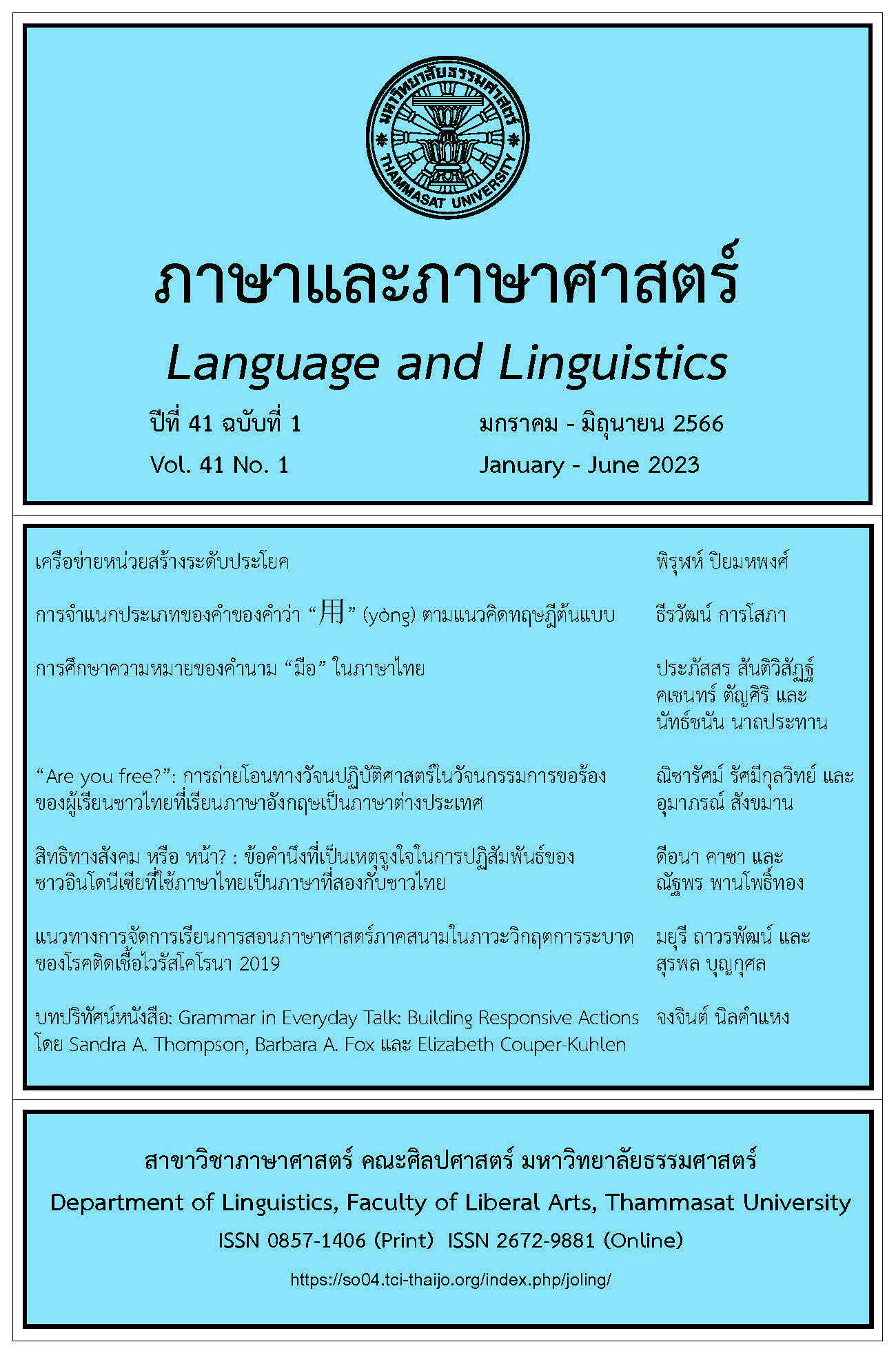Classification of “用” (yòng) According to Prototype Theory
Main Article Content
Abstract
The classification of “YONG” in the sentence structure YONG + object + verb + object into a preposition or verb and which type of sentence structure this is has been controversial in Chinese linguistics. Traditional linguistic theory has been unable to clearly explain the scope of Chinese word types. Therefore, there has been an analysis of the characteristics of Chinese verbs and prepositions and the coefficients have been aligned with the Prototype Theory of Cognitive Linguistics in order to classify the word boundaries for the word “YONG”. The conclusions of the study are that the word “YONG” functions as a causative verb and the sentence structure YONG + object + verb + object is a serial verb construction. Furthermore, the classification of words using Prototype Theory is able to solve the problem outlined above. The results from this study are consistent with the reality of Chinese language education, reasonably explain the controversies of the word “YONG” and are also beneficial for teaching Chinese grammar and structure.
Article Details

This work is licensed under a Creative Commons Attribution-NonCommercial-NoDerivatives 4.0 International License.
บทความทุกบทความเป็นลิขสิทธิ์ของภาษาและภาษาศาสตร์
References
จรัลวิไล จรูญโรจน์, ม.ล. (2552). ความสัมพันธ์ระหว่างความเคร่งครัดทางศาสนากับการตีความหมายของคำว่า “โกหก” ในภาษาไทย: การวิเคราะห์เชิงอรรถศาสตร์ต้นแบบ. ภาษาและภาษาศาสตร์, 27(2), 1-20.
เธียรชัย เอี่ยมวรเมธ. (2563). พจนานุกรมจีน-ไทย (ฉบับใหม่). อมรการพิมพ์.
บัณฑิตา อินสมบัติ, นิเวศ คำรัตน์, พรรณราย เทียมทัน, สุธาทิพย์ งามนิล และพรสิริ เอี่ยมแก้ว. (2564). การพัฒนาบทเรียนออนไลน์ตามทฤษฎีโครงสร้างความรู้เรื่องการกำหนดปัญหาการวิจัย สำหรับนักศึกษาบัณฑิตศึกษา. วารสารวิชาการและวิจัยสังคมศาสตร์, 16(3), 101-113.
Chen Changlai 陈昌来. (2002). 介词与介引功能. 安徽教育出版社.
Chen Changlai 陈昌来. (2015). 汉语 “介词框架”研究. 商务印书馆.
Chen Hongyan 陈红燕. (2007). 现代汉语 “用” 字框架研究述评. 合肥学院学报 (社会科学版), (6), 101-105.
Gao Shunquan 高顺全. (2002). 动词虚化与对外汉语教学. 语言教学与研究, (2), 19-23.
Geeraerts, Dirk. (2010). Theories of lexical semantics. Oxford University Press.
Guo Rui 郭锐. (2002). 现代汉语词类研究. 商务印书馆.
Institute of Linguistics, CASS 中国社会科学院语言研究所词典编辑室. (2017). 现代汉语词典 (第七版). 商务印书馆.
Lu Shuxiang吕叔湘. (1999). 现代汉语八百词. 商务印书馆.
Ma Jianzhong马建忠. (1998). 马氏文通.北京. 商务印书馆.
Si Erzhong斯尔螽. (1957). 谈介词结构的用法. 语文知识, (6), 32-34.
Taylor, John R. (1995). Linguistic categorization: Prototypes in linguistic Theory (2nd ed.). Clarendon Press.
Tang Yuhuan 唐玉环. (2009). 功用句 “用X” 格式的信息结构分析. 湘潭 师范学院学报 (社会科学版), (1), 130-131.
Wang Yin王寅. (2013). 范畴三论: 经典范畴、原型范畴、图式范畴——论认知语言学对后现代哲学的贡献. 外文研究, (1), 20-26.
Yuan Yulin袁毓林. (2010). 汉语词类的认知研究和词类的模糊划分. 上海教育出版社.
Zhang Bin 张斌. (2010). 现代汉语描写语法. 商务印书馆.
Zhao Kuixin 赵葵欣. (2000). 留学生学习和使用汉语介词的调查. 世界汉语教学, (2), 100-106.
Zhao Yuanren 赵元任. (1979). 汉语口语语法 (吕叔湘译). 商务印书馆.
Zhao Zhongxing赵中兴. (2016). 现代汉语词类划分标准研究评述. 现代语文 (语言研究版), (1), 31-33.
and 1957 language classes of the Chinese Department of Peking University北京大学中文系1955和1957级语言班. (1996). 现代汉语虚词例释. 商务印书馆.


